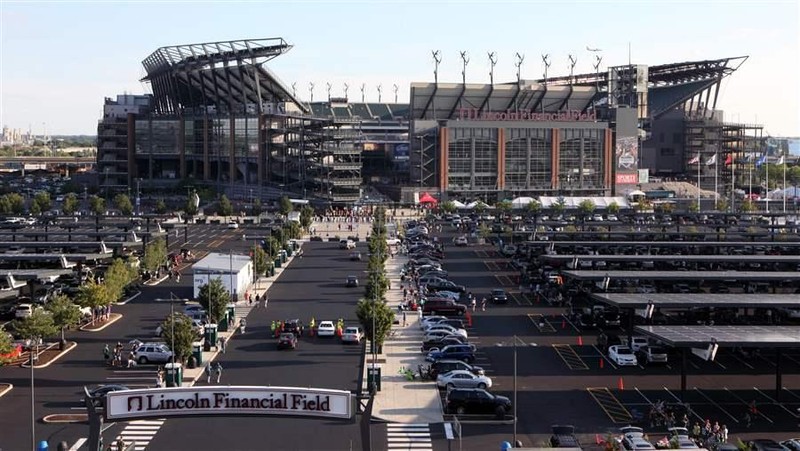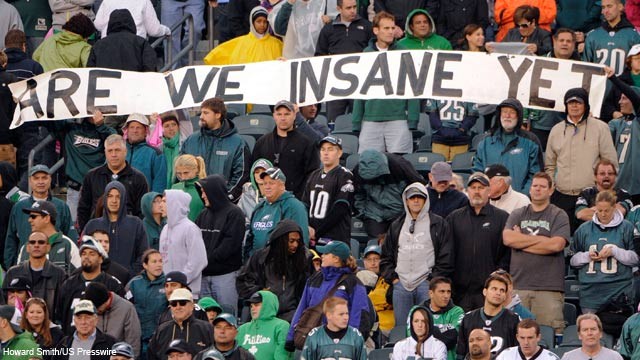Lincoln Financial Field
Introduction
Text-to-speech Audio
Images
Lincoln Financial has the largest array of solar panels than any other stadium in the NFL http://www.pewtrusts.org/en/research-and-analysis/analysis/2014/12/05/keystone-state-emerges-as-rising-clean-energy-leader

Fly birds fly http://www.5pointsblue.com/proof-eagles-fans-really-worst/

Backstory and Context
Text-to-speech Audio
Fly Birds Fly
Lincoln Financial Field, located in the South Philadelphia area, has been home to the Philadelphia Eagles since its grand opening in 2003. This 512 million dollar stadium gained the nickname, “The Linc” by the notoriously rowdy Eagles fans and they praise it like no other stadium in the area. The stadium has 68,532 seats, with the majority of these being situated along the sidelines, creating an excellent viewing experience for these birds fans. So why did this fan crazed stadium ever become a loving landmark for Philly fans? The Eagles used to share the old and decrepit Veterans stadium with the Philadelphia Phillies and it was considered one of the worst venues in the entire league. The Vet was built in 1971, and talk about building a new stadium for both these teams started all the way back in 1993, eight years before actual construction began (“Lincoln Financial Field”). The turf was even considered one of the worst playing surfaces in the league. The fans, players, coaches, and owners of the Eagles were all ready for a new stadium and in April 2001, Lincoln Financial began construction. The new stadium was being built adjacent to the old Veterans Stadium. Following the stadium's opening in 2003, the first ever sporting event held at the field was a intense soccer match between Manchester United and FC Barcelona. This game paved the way for several other soccer teams to grind it out on the pitch at this venue, including the Women's US soccer team who held several FIFA World Cup matches here (Kelly, 2015).
Ever since its grand opening in 2003, Lincoln Financial Field has made it a main priority to become one of the few solely energy self-sufficient stadiums in the world and reduce its environmental footprint. The stadium is well known for its full commitment to its waste management and renewable energy programs. Studies have shown that a single NFL game with 70,000 people in attendance produces 58 tons of carbon dioxide emissions and around 15-25 tons of landfill waste per game. As part of the “Go Green” initiative, the Natural Resources Defense Council (NRDC), city officials, and other businesses fitted the facility with over 11,00 solar panels and 14 wind turbines that supply over 4mw of generating capacity. The majority of these solar panels are located in the parking lot, which happens to be the largest array of solar panels in Philadelphia. This array of solar panels at Lincoln Financial is also the largest of any stadium in the NFL. The solar panels supply the bulk of the self sufficient energy while the wind turbines have been explained by the Eagles president Don Smolenski, as more of “...a visual representation of our commitment to sustainable efforts” (Simon, 2016). One of the biggest accomplishments that this initiative has achieved is a 99.8 percent waste diversion rate through numerous recycling and compositing programs. These efforts have shown to save the stadium over 140 tons of waste from reaching landfills every season (“The Interesector Project”).
The stadium has truly designated itself as one of a kind. Efforts to become a self sufficient stadium or hosting some of the most memorable football games in history (such as numerous Army vs Navy games) has helped set it apart from other venues. But, what is a notorious football stadium without notorious fans? And the Philadelphia Eagles fans have really put themselves on the fan base map in a negative way. Their reputation as some of the worst fans in football dates all the way back to 1983 when they decided to assault one of the pride and joys of the Washington Redskins, not once, but twice. Zema Williams is recognized by Redskins fans as Chief Zee and is a well known aspect at every game. He wore his customary chief costume to Veterans Stadium for an away game and had his clothes ripped and torn by eagles fans. The same two fans who were credited with that cruel act decided to jump and assault him in the parking lot after the game and broke his leg (Hailey, 2014).
Another prime example of the nastiness of these fans is when Donovan McNabb made his first appearance at Veterans Field after he was drafted in 1999. He walked onto the field and got viciously booed because he wanted the draft pick that the fans wanted. Imagine getting drafted 2nd overall, after the Browns quarterback Tim Couch of all people, and the fans were beyond angry. Donovan went on to be one of the best quarterbacks in Eagles franchise history and still will probably never forget his enjoyable welcome party to the team. Last, but not least is the notorious bombardment of snowballs at Santa Claus in 1968. After a disastrous season was about to come to an end, the Eagles were getting ready for their annual Christmas themed halftime show for the last game of the year. When the hired Santa Claus did not show up due to a snowstorm, a random fan dressed as Santa Claus was picked out of the crowd as the replacement. Now I am not sure if it was because he was not the real Santa, or if it was because the fans were just done with one of their worst seasons to date, but the halftime show did not go as planned. Kris Kringle was bombarded with snowballs and did not stand a chance. The fans may have been letting out their true anger at the fact that their record was 0-12, but decided to win the last two games of the year and throw away their 1st overall draft pick for OJ Simpson. But, honestly who throws snowballs at Santa Claus?
This stadium might be fourteen years old, but it is still considered one of the more likeable ones in the NFL. This stadium is the star child of the NFL, but for some reason is not getting the recognition it deserves because of the fans overwhelming notoriety. Maybe the fans aren’t realizing the gift they have here and the benefits this stadium is providing to the City of Philadelphia, or maybe they do. Either way, I believe this stadium deserves a little more recognition and better behavior.
Sources
Hailey, Peter. “10 Times Philadelphia Fans Were Truly the Worst.” NBC Sports Washington, 15 Aug. 2016, www.nbcsports.com/washington/washington-redskins/10-times-philadelphia-fans-were-truly-worst-philade....
“Lincoln Financial Field, Philadelphia Eagles Football Stadium - Stadiums of Pro Football.” Stadiums of Pro Football, www.stadiumsofprofootball.com/stadiums/lincoln-financial-field/.
Kelly, R. “Lincoln Financial Field — Visitphilly.com.” Philadelphia - Official Visitor Site - Visitphilly.com, The Eagle's Nest, 12 Jan. 2015, www.visitphilly.com/sports/philadelphia/lincoln-financial-field/.
Simon, Mollie. “Philadelphia Eagles Go Green with Renewable Energy.” Philadelphia Eagles Go Green with Renewable Energy | Kleinman Center for Energy Policy, Penn Design, 29 June. 2016, kleinmanenergy.upenn.edu/blog/2016/06/29/philadelphia-eagles-go-green-renewable-energy.
